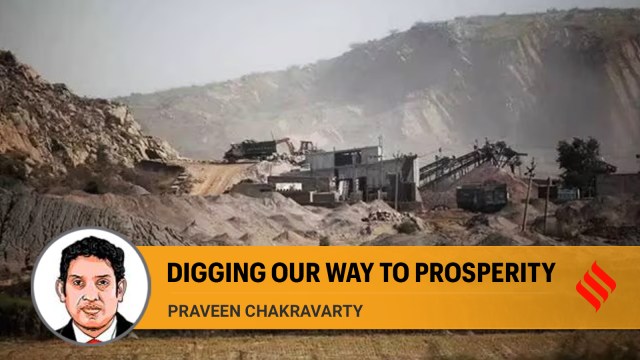In the contest between livelihoods for millions and ecological conservatism, the need is for a delicate balance tilted towards livelihoods. It is time for India to ‘dig its way’ to prosperity.
Praveen Chakravarty
November 20, 2023

The transition in global mobility from oil to electric is now a given. The current global order was established after World War II on the back of oil-based combustion-engine technology.
“Afghanistan can be the Saudi Arabia of lithium,” noted The Washington Post on July 23. In a brilliantly investigated ground report, the article cited a US Department of Defence finding that the Hindu Kush Mountain range in the Nurestan province in Afghanistan could potentially possess a trillion dollars’ worth of critical and rare earth minerals, but in an ironical twist to the tale, America’s foes, China and the Taliban, are now well positioned to reap these riches. However, this development could be significant for India’s economic future and its youth.
The transition in global mobility from oil to electric is now a given. The current global order was established after World War II on the back of oil-based combustion-engine technology. It is now being recast with electric mobility technology driven by batteries using minerals such as lithium, cobalt, nickel and rare earths. Demand for such minerals is expected to increase 20 to 40 times over the next few decades. These minerals are the new oil and the Hindu Kush mountain range could be the new Middle East. And this could be India’s opportunity.
Geological reports suggest that it is likely that such minerals could also be found in the northern Indian side of the Hindu Kush range since these were formed from tectonic shifts of the Gondwana supercontinent. This hypothesis has gained further credence with the early discovery of lithium in Jammu and Kashmir this year. India is one of the least explored and mined large countries in the world. Research suggests that less than 10 per cent of India’s landmass is explored and 2 per cent mined. To put it simply, we do not yet know the potential riches that may exist beneath our feet. With a long coastline and the emergence of deep-sea mining technologies, there could be further finds in our sea and ocean beds. Regardless of the eventual outcome of the discovery process, there is sufficient rationale for India to at least start large-scale exploration for critical minerals.
These global shifts and geological discoveries come at a time when there is a total breakdown between headline GDP growth and jobs for India’s youth. The government’s obsession with semiconductor manufacturing or a “fastest growing economy” tag means very little to the 150 million Indians still clamouring for minimum wage MGNREGA work. Mining and exploration are much more job-intensive than traditional manufacturing. The 12th Five Year Plan (2012-17) prepared by the Planning Commission during Manmohan Singh’s premiership said that for every percentage point of growth in economic activity, mining creates 13 times more jobs than agriculture and six times more than manufacturing. Mining and exploration employ relatively lower-skilled people than say semiconductor or automotive manufacturing. Large numbers of local, unskilled jobs mean greater employment opportunities for backward castes, Dalits and tribals.
It is well known that, in the past, India’s central government and the Congress party have had a turbulent relationship with the mining sector. While there are legitimate environmental concerns, land acquisition and labour conditions are more pressing issues around mining in India. The private sector’s track record in mining has not been exemplary. But just as incidents of drunk driving are not a reason to ban driving, past shenanigans by mining companies are not a reason to shun mining. India needs a robust set of environmental protection, labour and land laws to prevent loot and capture; this should be enforced by competent regulators. Succumbing to the temptations of nationalising mining and exploration through the public sector for fear of private sector cronyism can be “rupee wise, lithium foolish”.
Mining and exploration are capital and technology-intensive, especially with developments in deep-sea mining. It is the private sector that is capable of bringing in the latest foreign technologies, large amounts of capital and deploying it efficiently. There is a global critical minerals race underway with countries such as Indonesia, the Republic of Congo, Chile, Australia and now Afghanistan in substantial lead. Efficiency and productivity in exploration and mining for rare earths and other minerals will be key to India’s ability to catch up and cater to global demand. An active government policy with incentives and strict regulations to spur large-scale private sector exploration for critical minerals and rare earths may just be what India’s jobless economic growth needs.
The Kennedy School of Government at Harvard University has launched an initiative, ‘Reimagining the economy’, that seeks to reshape economic development policies away from the current headline GDP obsession. This initiative — driven more by politicians, philosophers, political economists and sociologists than macro economists — calls for a government-directed active industrial policy with a focus on jobs and the labour market rather than on output and growth. This is the new ‘Boston Consensus’ to replace the 1990 ‘Washington Consensus’ economic doctrine. It is time for India to reimagine its economy. The measure of India’s economic success is not maximising GDP growth but minimising MGNREGA demand (naturally).
The global shift to electric mobility will trigger an exponentially rising demand for key minerals and rare earths. The mere quest for these minerals can generate meaningful jobs and incomes for hundreds of millions, predominantly from underprivileged castes. This is a unique economic opportunity where many stars seem to align in India’s favour. This is the sort of economic narrative that the opposition INDIA alliance can present to India’s youth.
Of course, indiscriminate mining and exploration can be ecologically damaging, but in the contest between livelihoods for millions and ecological conservatism, the need is for a delicate balance tilted towards livelihoods. It is time for India to “dig its way” in search of prosperity.
https://indianexpress.com/article/opinion/columns/india-mining-investment-9033998/
